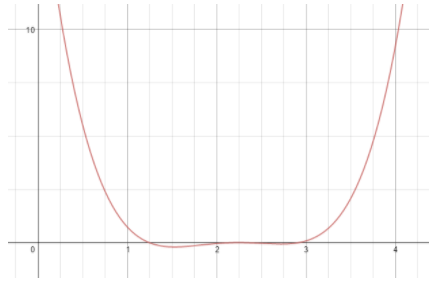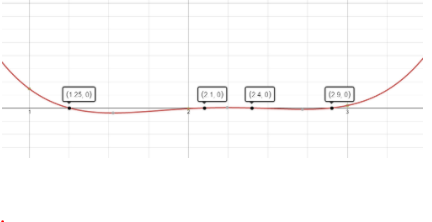
(a)
To Find: The degree, leading coefficient and the end behaviour.
(a)
Answer to Problem 46PPS
The degree is 1, the leading coefficient is 1 and the end behaviour is that both ends go up.
Explanation of Solution
Given:
The given function is
Calculation:
From the given function the degree is 4 as it is highest power of the function.
The leading coefficient 1 as it is the coefficient of the variable of the highest degree.
Consider the end behaviours as it is even degree polynomial and the leading coefficient is positive so the ends that will both go up.
(b)
To Find: The table of the integer values
(b)
Answer to Problem 46PPS
The required table for the 10 zeroes is shown in Table 1
Explanation of Solution
Consider the given function is,
The table to the integer values
Table 1
| -4 | 1414.224 |
| -3 | 690.5655 |
| -2 | 287.287 |
| -1 | 92.4885 |
| 0 | 18.27 |
| 1 | 0.7315 |
| 2 | -0.027 |
| 3 | 0.0945 |
| 4 | 9.916 |
The above table shows two change of signs and the number of zeroes.
Thus, the required table for the 10 zeroes is shown in Table 1
(c)
To Find: The graph for the function.
(c)
Answer to Problem 46PPS
The required graph is shown in Figure 1 and the zeroes from the graph is
Explanation of Solution
Consider the given function is,
The graph for the above function is shown in Figure 1

Figure 1
(d)
To Find: The change in the viewing window to
(d)
Answer to Problem 46PPS
The given graph is shown in Figure 2
Explanation of Solution
From the given graph shown in Figure the graph for the change in viewing window with the points marked is shown in Figure 2

Figure 2
From the above graph from the interval 1 to 3 there are four zeroes but not only two as it is determined in part (b) as,
Chapter 5 Solutions
Glencoe Algebra 2 Student Edition C2014
Additional Math Textbook Solutions
Pre-Algebra Student Edition
Introductory Statistics
A First Course in Probability (10th Edition)
Precalculus
Calculus: Early Transcendentals (2nd Edition)
Algebra and Trigonometry (6th Edition)
- A research study in the year 2009 found that there were 2760 coyotes in a given region. The coyote population declined at a rate of 5.8% each year. How many fewer coyotes were there in 2024 than in 2015? Explain in at least one sentence how you solved the problem. Show your work. Round your answer to the nearest whole number.arrow_forwardAnswer the following questions related to the following matrix A = 3 ³).arrow_forwardExplain the following termsarrow_forward
- Solve questions by Course Name (Ordinary Differential Equations II 2)arrow_forwardplease Solve questions by Course Name( Ordinary Differential Equations II 2)arrow_forwardInThe Northern Lights are bright flashes of colored light between 50 and 200 miles above Earth. Suppose a flash occurs 150 miles above Earth. What is the measure of arc BD, the portion of Earth from which the flash is visible? (Earth’s radius is approximately 4000 miles.)arrow_forward
- e). n! (n - 1)!arrow_forwardSuppose you flip a fair two-sided coin four times and record the result. a). List the sample space of this experiment. That is, list all possible outcomes that could occur when flipping a fair two-sided coin four total times. Assume the two sides of the coin are Heads (H) and Tails (T).arrow_forwarde). n! (n - 1)!arrow_forward
 Algebra and Trigonometry (6th Edition)AlgebraISBN:9780134463216Author:Robert F. BlitzerPublisher:PEARSON
Algebra and Trigonometry (6th Edition)AlgebraISBN:9780134463216Author:Robert F. BlitzerPublisher:PEARSON Contemporary Abstract AlgebraAlgebraISBN:9781305657960Author:Joseph GallianPublisher:Cengage Learning
Contemporary Abstract AlgebraAlgebraISBN:9781305657960Author:Joseph GallianPublisher:Cengage Learning Linear Algebra: A Modern IntroductionAlgebraISBN:9781285463247Author:David PoolePublisher:Cengage Learning
Linear Algebra: A Modern IntroductionAlgebraISBN:9781285463247Author:David PoolePublisher:Cengage Learning Algebra And Trigonometry (11th Edition)AlgebraISBN:9780135163078Author:Michael SullivanPublisher:PEARSON
Algebra And Trigonometry (11th Edition)AlgebraISBN:9780135163078Author:Michael SullivanPublisher:PEARSON Introduction to Linear Algebra, Fifth EditionAlgebraISBN:9780980232776Author:Gilbert StrangPublisher:Wellesley-Cambridge Press
Introduction to Linear Algebra, Fifth EditionAlgebraISBN:9780980232776Author:Gilbert StrangPublisher:Wellesley-Cambridge Press College Algebra (Collegiate Math)AlgebraISBN:9780077836344Author:Julie Miller, Donna GerkenPublisher:McGraw-Hill Education
College Algebra (Collegiate Math)AlgebraISBN:9780077836344Author:Julie Miller, Donna GerkenPublisher:McGraw-Hill Education





